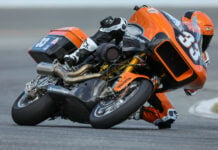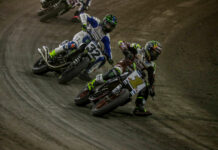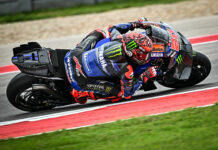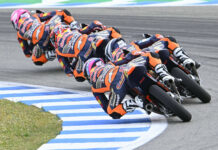Copyright 2003, Roadracing World Publishing, Inc.
Pikes Peak International Raceway has been the site of a series of controversial penalties in the Supersport class, some of which may have serious Championship implications.
Yoshimura Suzuki’s Ben Spies was fined $2000 and penalized 20 Championship points for a technical violation found following his Supersport race win at Road Atlanta. Parts from Spies’ GSX-R600 were impounded after the Road Atlanta race, and later inspected against control production parts.
The Yoshimura Suzuki team learned of the judgment against Spies on Wednesday, May 28 at Pikes Peak International Raceway, but the final determination of Spies’ violation wasn’t announced by AMA Pro Racing until a little after noon (Mountain Time) Sunday, June 1–in response to a SPEED TV report by Greg White, who broke the news of the penalty.
According to Yoshimura Team Manager Don Sakakura, Spies was found to have an “oil pressure relief valve…different than the production sample.” Asked how the part got into Spies’ Suzuki, Sakakura declined to comment.
“The ruling is fine,” continued Sakakura, “as long as, again, (the AMA is) consistent as far as the way they enforce the rules. I understand the penalty, and we’ll abide by the penalty.”
Then, after Spies was penalized but before Spies’ penalty was announced, AMA Pro Racing pulled “about 10 bikes,” into technical inspection following Supersport qualifying May 31, according to AMA Pro Racing’s Ron Barrick. Mechanics were asked to remove the exhaust systems and oil pans from the racebikes.
During those inspections, bikes ridden by American Honda’s Miguel Duhamel, Erion Honda’s Jake Zemke and Bruce Transportation Group Honda’s Marty Craggill were found to have “non-standard oil pressure relief valves.” In addition, Craggill’s Honda was found to have a “non-standard charging system,” according to a May 31 AMA Pro Racing release.
The penalties against the Honda riders were immediately announced by AMA Pro Racing, while the penalty against Spies was not announced until after the SPEED TV report aired the next day.
Duhamel and Zemke were each fined $2000, penalized 20 Supersport Championship points and moved to the last grid spots for Sunday’s Supersport final.
That penalty–combined with his still-healing shoulder injury– resulted in Duhamel withdrawing from the Supersport race at PPIR.
For his dual penalties, Craggill was penalized 20 points, disqualified from the Supersport race at Pikes Peak and fined $2500. Craggill did not return to the track Sunday.
“We felt we were legal and in compliance with all rules and production pieces and everything,” Honda Racing Teams Manager Chuck Miller told Roadracingworld.com Sunday in the Pikes Peak paddock. “Even our liaison here (from Japan) expressed that thought. So when we found out that the AMA found inconsistencies in our part versus their part, we suggested to take the production bike down there and pull it apart and see what’s in it. Because we feel ours is the same as that.
“So we did do that, and we did find out it was different. And that there was a change in the vendor (part supplier) from early-production to a production version. And in doing so there was a different tension rate on the spring. So we were found illegal.
“We accept responsibility for that fully. We aren’t going to appeal the process, in that regards. It wasn’t done intentionally, and we are now undergoing a thorough investigation of every other part to make sure there wasn’t any inconsistencies from early production versus production.
“As you know we got these bikes prior to Daytona to race at the Daytona event.”
The part in question was an oil pressure relief valve spring located in the oil sump of the Honda CBR600RR. The two-inch-long spring is visually identical to the production part but had a different spring rate, which was checked by the AMA Pro Racing technical staff with an Intercomp spring tester. According to Miller, the non-standard part could theoretically reduce oil pressure and allow the engine to rev more freely. Miller said that the modification would not increase horsepower or torque and, at best, would provide a “minimal” advantage.
In addition to the same non-standard spring, Craggill’s CBR600RR was found to have what Miller believes was a race kit ignition stator/rotor.
According to Bruce Transportation Group Honda Crew Chief Joey Osowski, the original engine cover and stator/rotor assembly were damaged in a crash earlier this season and the standard Honda parts needed to replace the cover and ignition parts were on back-order from Honda.
Osowski said that during the inspections, the AMA Pro Racing technical inspectors saw that the engine cover was different and then asked to see the entire charging system. “The cover and the winding were aftermarket, just different than the U.S. model,” said Osowski.
As for Osowski’s reasoning for using the aftermarket/kit parts, Miller acknowledged that the parts were back-ordered at the time of Craggill’s crash but added, “That’s not an excuse because the parts are fully available at this point.”
AMA Pro Racing sources did not agree with Miller’s assertions regarding the effect reducing oil pressure relief valve spring pressure would (or would not) have on horsepower production, stating that because it takes horsepower to drive the oil pump, reducing oil pressure also reduces mechanical power losses and increases power reaching the rear wheel.
Attack Suzuki’s Richard Stanboli said, “It should benefit a 600 more than a 750. You can figure one horsepower for every 10 psi you take off the oil pressure. For instance, if your bike makes 60-80 psi at maximum rpm, if you can bypass the pressure relief valve at 30 psi, you gain more than 3 horsepower.”
Kawasaki engine builder Theo Lockwood said that the World Superbike team he used to work for got a different oil pump assembly two years ago, and that it made a 2-3 horsepower gain on a 150-horsepower engine. Lockwood said reducing oil pressure would typically result in a 1-2 percent gain.
As far as Honda claiming the Honda, Erion and Bruce racebikes had a pre-production part, Lockwood said “We had pre-production bikes and parts, too, but we made a concerted effort to make sure we showed up at Daytona with a production bike. Every team starts with pre-production bikes and it’s up to them to make sure it’s legal.”
AMA officials actually tested 9 bikes after Supersport Qualifying at Pikes Peak, specifically taking one from the American Honda team, one from Erion Honda, and one from Bruce Transportation Honda, as well as two Yamahas, two Kawasakis and two Suzukis.
“We’re looking at more things,” said a source in AMA tech. “We’re trying to make a level playing field. Now we have some new equipment that allows us to check more things with confidence. We knew Spies’ oil pump was bad at the track at Road Atlanta, but we wanted to do more testing on it for research.”
Updated Post: On Supersport Punishment And Penalties In Colorado
Updated Post: On Supersport Punishment And Penalties In Colorado
© 2003, Roadracing World Publishing, Inc.






